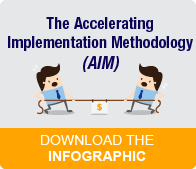Benjamin Franklin once said, “By failing to prepare, you are preparing to fail.” That’s why we find it rather puzzling when organizations initiate any type of change without a Change Implementation Plan. 
In fact, after almost 40 years of hands-on Change Management Consulting and Training work, we contend Implementation Management Planning is arguably the single most important step to be taken when starting a new change project, whether it’s transformational in scope or a more modest change.
How to Build an Implementation Plan
When building a Change Implementation Plan there are several key steps that must be addressed. At a minimum, an Implementation Plan must include a Business Case for Action as well as strategies for:
- Sponsorship
- Readiness
- Reinforcement and
- Communication
Below we take a closer look at each step in the process.
Develop a Business Case for Action
As project teams are formed and work begins, your first task is to get agreement on the scope of the project as well as to set project goals. This will lead to your first deliverable; a clear and compelling Business Case for Action. The Business Case for Action (BCA) provides the foundation for building organizational alignment around the project, and the new behaviors you seek to see. A solid BCA must answer three questions:
- What are we changing?
- Why are we changing?
- What happens if we don’t succeed?
The definition of the change as described in the BCA must be translated into the Frames of Reference for the various Target groups so that it is positioned from their perspectives, not from the perspective of management. This is why the BCA is a living, breathing document that is used, modified, and updated throughout the project lifecycle.
Getting a solid BCA can take weeks to develop. But there is a way to shorten the process. Our Project JumpStart, is a facilitated 2 day session that helps project teams to develop an initial Business Case for Action and identify the new behaviors which are the human objectives for the project. So many projects go off the rails right at the start because there is no alignment or there are unresolved differences!
Generate Sponsorship
Sponsorship for the change is the responsibility of every manager who has direct reports that are impacted by the change. Change is accelerated when what these leaders say, do, and reinforce are all aligned and serve to demonstrate commitment to the change. Every Change Implementation Plan should have an explicit strategy for ensuring this level of commitment at the beginning, middle, and end of the project lifecycle.
TIP: AIM’s Key Role Map helps give a visual depiction of the precise organizational location of Authorizing Sponsors, Reinforcing Sponsors, Change Agents, and Targets of the change. While it may take time to develop a good Key Role Map, it is an invaluable tool and provides the project team with significant insights into what level of resources will be needed to implement the project at the local level. We teach our change management training participants how to build a Key Role Map in the AIM Accreditation program.
Develop Target Readiness
A Readiness Strategy should be built into the project plan as a way to measure the progress of adoption of new behaviors. But remember, building readiness is not a check-the-box activity. In other words, you cannot check it off your list and then forget about it. Sources of resistance will be different at the beginning, middle and end of the project, so you will need to deploy different strategies and tactics as you go.
TIP: AIM’s Individual Readiness Assessment tool helps the project team identify the likely sources of resistance so that tactics and strategies can be deployed to shorten the duration and depth of the resistance. The data enables the team, Change Agents, and Sponsors to understand how the change is perceived from the Frame of Reference of the Targets.
Build a Communication Plan
A Communication Plan is not the same thing as a complete Implementation Plan; it is just one component {Tweet This}. The AIM methodology centers communication efforts on delivering the right message to the right audience at the right time, using the right communication vehicles, and always includes a feedback loop to gather reactions to both the content of the change, and how the change is being implemented. It is important to get both types of reactions, because you will get resistance to both the content of the change, and the implementation process itself.
Develop Reinforcement Strategy
Every best practice Implementation Plan must include a Reinforcement Strategy that helps Sponsors and Change Agents apply immediate and certain behavioral reinforcement at the local level for the implementation-specific behaviors you seek to see for that change. The “menu” of formal and informal reinforcements should be developed from the Frame of Reference of the Targets.
Your Change Implementation Plan isn’t separate from the Project Plan. It is part of that Plan! Integrated together, your team has a plan that can be monitored, updated, and modified as your change changes. And it will, we guarantee that! Change is iterative and cyclical. Your Implementation Plan should be the same.


